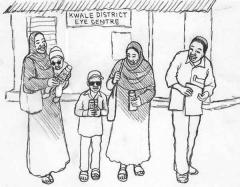Your progress
0%
complete
We’d now like you to consider the example of a CBR activity in Kenya.
Please select Learn more to read about this story.
Learn how CBR in Kenya helped to overcome stigma and prejudice against children with albinism in their homes.


In some African cultures, albinism is believed to be a result of a mother having a “sexual relationship” with evil spirits during pregnancy. Having a child with albinism is considered immoral, and both the family and child are subject to discrimination and stigmatization. Children with albinism remain hidden and their fundamental human rights — including their right to health – are denied.
Kwale District Eye Centre (KDEC) in Kenya has a CBR programme that focuses on alleviating discrimination and stigmatization towards children with albinism in their homes, schools and community environments. To ensure these children achieve their highest attainable level of health, the CBR programme uses a variety of health promotion activities and interventions, including:
Thanks to the strong working relationship that KDEC has developed with both the health and education sectors, children with albinism are now integrated into mainstream schools.
When you are finished reading, take a few moments to consider:
Enter your thoughts in the box below and select Save.